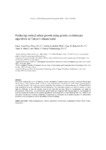Predicting vertical urban growth using genetic evolutionary algorithms in Tokyo’s minato ward

Ver/
Use este enlace para citar
http://hdl.handle.net/2183/22136Coleccións
- Investigación (FIC) [1678]
Metadatos
Mostrar o rexistro completo do ítemTítulo
Predicting vertical urban growth using genetic evolutionary algorithms in Tokyo’s minato wardAutor(es)
Data
2018-03Cita bibliográfica
Pazos Pérez RI, Carballal A, Rabuñal JR, et al. Predicting vertical urban growth using genetic evolutionary algorithms in Tokyo’s minato ward. J Urban Plan Develop. 2018; 144(1): 04017024
Resumo
[Abstract] This article explores the use of evolutionary genetic algorithms to predict scenarios of urban vertical growth in large urban centers. Tokyo’s Minato Ward is used as a case study because it has been one of the fastest growing skylines over the last 20 years. This study uses a genetic algorithm that simulates the vertical urban growth of Minato Ward to make predictions from pre-established inputted parameters. The algorithm estimates not only the number of future high-rise buildings but also the specific areas in the ward that are more likely to accommodate new high-rise developments in the future. The evolutionary model results are compared with ongoing high-rise developments in order to evaluate the accuracy of the genetic algorithm in simulating future vertical urban growth. The results of this study show that the use of genetic evolutionary computation is a promising way to predict scenarios of vertical urban growth in terms of location as well as the number of future buildings.
Palabras chave
Urban morphogenesis
Genetic algorithms
Evolutionary computation
Minato Ward
Tokyo
Skyscrapers
Genetic algorithms
Evolutionary computation
Minato Ward
Tokyo
Skyscrapers
Versión do editor
ISSN
0733-9488





